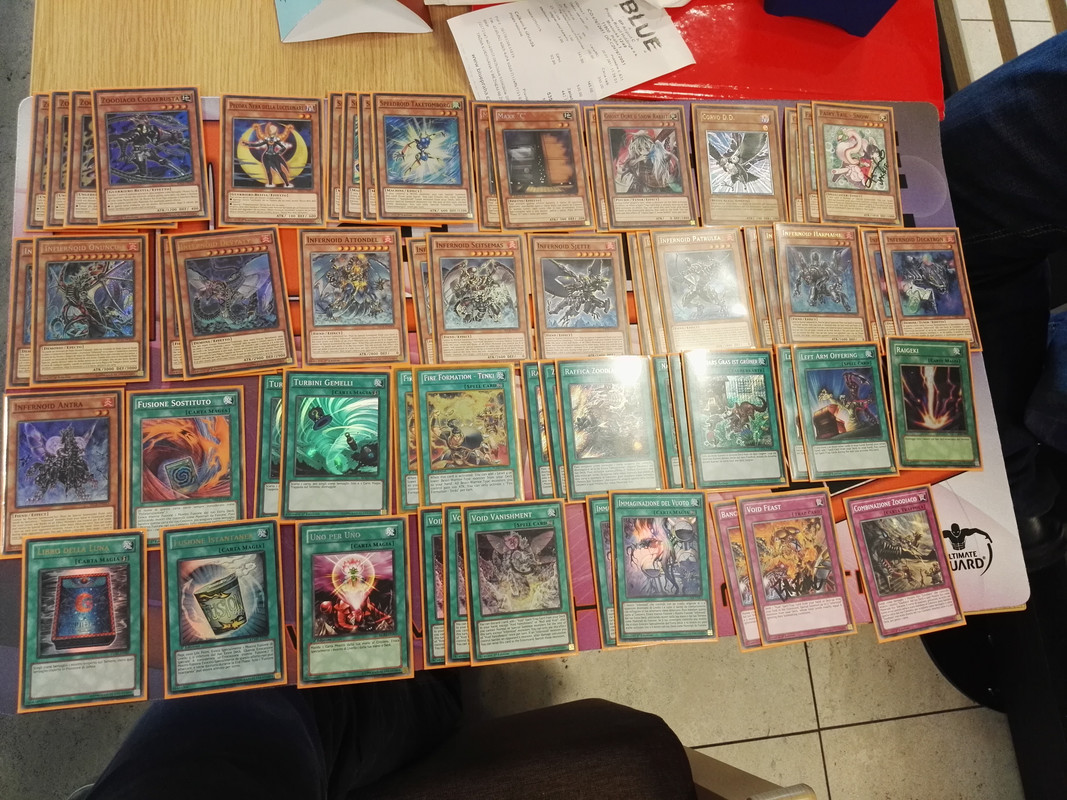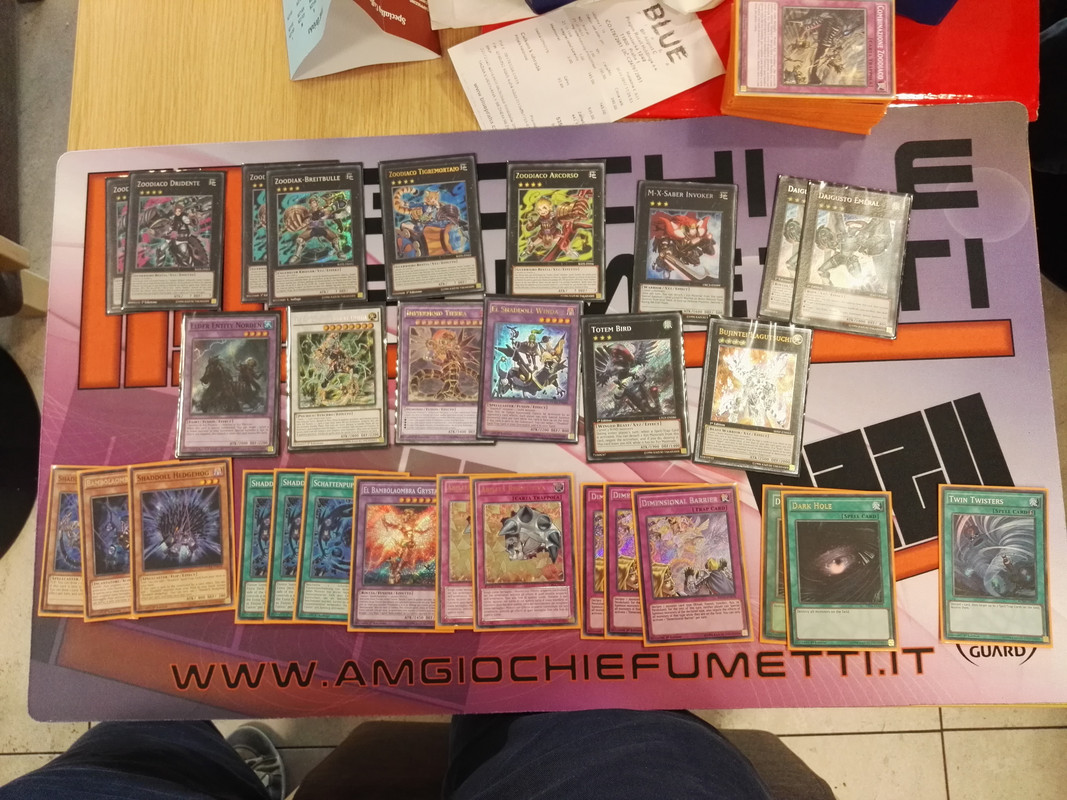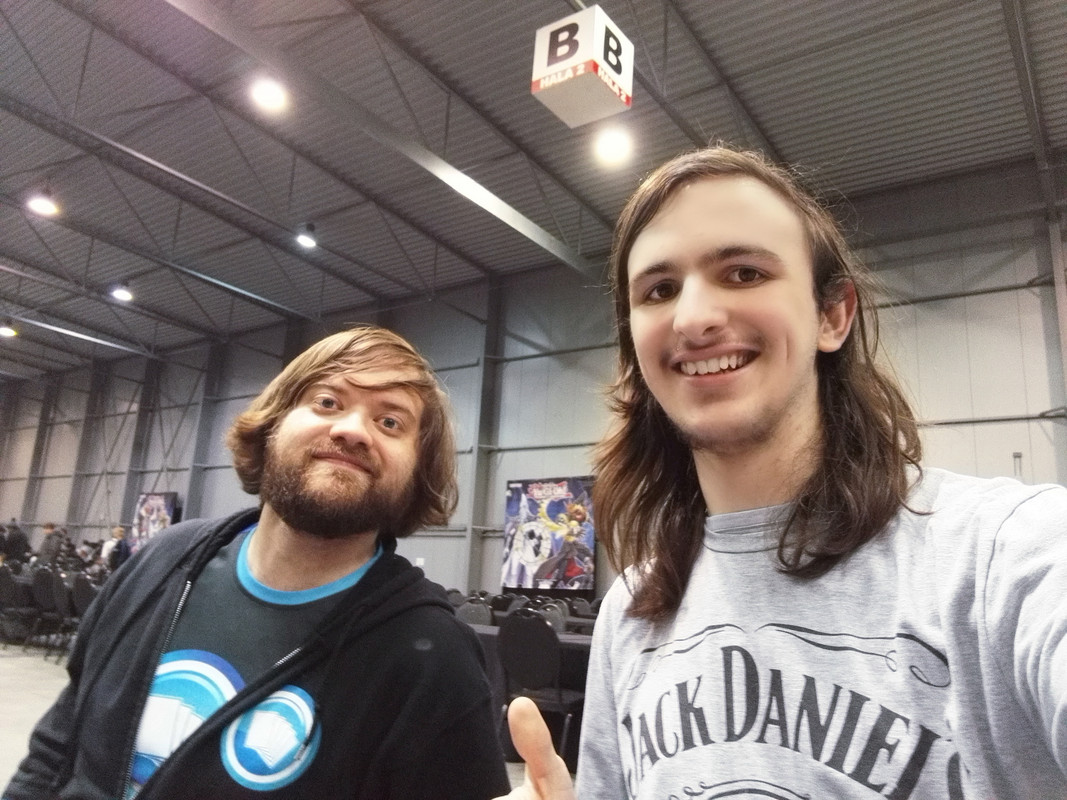Goat Format Goat Format CITAZIONE
La Banned List
La Deck Gallery del formato
I Rulings
Un'introduzione al formato: -Why is it Called the Goat Format?-
Un articolo che spiega come siddare in Goat Format: How to Side in Goat Format
Un articolo sulla controversa questione riguardante la carta "Exarion Universe": Recently, in the online goat format community, an issue has risen regarding whether to allow the card Exarion Universe in goat format. Luckily, people on both sides of the issue do not seem to feel strongly about it, so it has not caused a huge divide within the community. However, it is relevant, it is a complicated issue, and both sides of the argument have not attempted to make well thought out points.
Three Possible Goat Formats
There have always been three possible goat formats that people consider playing. There are other possible ones, but no one seems to be in favor of playing a goat format without The Lost Millenium for example, so those more obscure and less favored possible formats are not going to enter the argument for today.
The first possible format is without Exarion Universe or Cybernetic Revolution. This is the format that I favor. Historically speaking, SJC New Jersey, SJC Charlotte, US Nationals, SJC Seattle, and SJC Indianapolis were played with this format.
Then there’s the format with both Exarion Universe and Cybernetic Revolution. Historically speaking, SJC Boston was played with this format.
And that brings us to the last format, the one is appears to have the favor of the online community currently, goat format without Cybernetic Revolution and with Exarion Universe. Historically speaking, no premier events were played with this format. This begs the question, what’s up with that exactly?
Where Exarion Universe and Cybernetic Revolution Fit Into Yugioh History
One issue was that it was not clear if a format with Exarion Universe and without Cybernetic Revolution had actually ever existed in real life. Exarion Universe was first officially released in the TCG on September 1st, 2005. Cybernetic Revolution was first officially released in the TCG on August 17th, 2005. However, at this time, booster sets were not immediately legal upon their release. We know that SJC Indianapolis was held just three days later, on August 20th, and Cybernetic Revolution was not legal then.
Personally, I recall that booster sets were made legal two weeks after their official release. The UDE web archive confirms this:
http://web.archive.org/web/20051026025152/...n/products.aspx Interestingly enough, this would mean that Cybernetic Revolution would have been legal for premier tournament play on the exact same day that Exarion Universe was legal for premier tournament play.
Why Does This Matter?
Some would argue that it really doesn’t matter at all. In fact, I’d even say that that is a fair opinion to have. People do in fact have the right to play formats that never actually existed. However, for some, playing past formats has a nostalgic value, and they would prefer their formats to be historically accurate. This particularly applies to those who were actually playing competitive yugioh in 2005, but I realize that this is 2015 and that those people are a minority.
Now that DuelistGroundz.com’s retro format community is growing, we are beginning to delve into many retro formats, and we generally air on the side of historical accuracy. For example, it’s finally starting to become accepted that allowing OTK decks is more fair to the community. There are of course some exceptions. For example, I would advocate banning Crush Card Virus in the September 1, 2007 Perfect Circle format. This is because that I feel that Crush Card Virus adds significantly more luck to the format in such a way that it outweighs the need for historical accuracy (and really there's no way to be historically accurate in the strictest sense, unless we give only 1% of the players the ability to use the card).
Exarion Universe however goes in the opposite direction. Removing overpowered cards from the format in order to make it more fun or more skill-intensive is one thing. Adding cards to the format is another. Kris Perovic for example, once suggested experimenting with adding Effect Veiler, a card that was released in 2010, to goat format. No one took his suggestion seriously. The premise seemed ridiculous. But ironically enough, at the time he made that suggestion, we were all playing with Exarion Universe.
What Do We Want Goats to Be Like?
This is really the first question that the community needs to answer before the discussing about Exarion Universe can even begin. A discussion needs to be opened in regards to what qualifies as a “better” goat format. In general there are two components of better: more skillful and more fun.
Goat Format is not necessarily the consensus favorite retro format of the community, but I feel that the people who play it do for very specific reasons. One of these reasons can be identified just by looking at the name of the format: Goat Control. It wasn’t named the Airknight Aggro format or the Tsuku Lock format. One of the defining characteristics or the format is control decks that revolved around the card Scapegoat. But why does this make for an enjoyable format? A part of this is the snail's pace that the games were played at. With many turns and often many decisions to make on each turn, this makes for a very skillful game. While we’re still playing a game of Yugioh, not chess, games were fought over attrition, and players had opportunities to play tight and come back from opening hands that were more powerful than theirs. This was in large part due to the card Scapegoat. The card was chainable and could single-handedly wall the opponent out of more than 3000 points of damage, and a followup Metamorphosis could completely re-stabilize the board. We want this to be an aspect of the format.
We want Goat Control to emphasize very precise and deliberate play. We want Goat Control to be about planning ahead. We want Goat Control to reward those who don’t squander their advantage and are able to claw back into the game from behind.
Not only do we play Goat Format to reward duelists with tight, technical play, we also want it to reward those with good deck construction fundamentals as well. We don’t want to play a 100% solved format. Like technical play, which is about players gaining slow incremental advantages over each other, deck construction should also emphasize these small edges. While technical play may emphasize the conservation of the staple power cards, deck construction should reward those who find the small but useful tech for a given field. Whether it’s those who play Mystic Tomato in a field full of Dekoichis, or those who decide to play the third Sakuretsu Armor as a hedge against aggro, every card in your deck should have a reason behind it, and lists should be slightly evolving from month to month.
What Does Exarion Do To The Format?
First and foremost, it is a counter to Scapegoat. This isn’t inherently a bad thing; counters to cards should exist. However, when you compare Exarion Universe to other counters that exist to Scapegoat, you’ll start to see a lot of differences.
The other playable counters to Scapegoat in the format are Airknight Parshath, Asura Priest, King Tiger Wanghu, and Enraged Battle Ox. Airknight Parshath and Asura Priest are the two that can be played in a standard goat list, whereas King Tiger Wanghu and Enraged Battle Ox are build around cards.
Airknight Parshath is in some sense similar to Exarion Universe. It has similar stats. It has trample. It’s chaos-typed. Of course the one glaring difference is the fact that Airknight Parshath requires a tribute. While Airknight Parshath can bury the opponent in card advantage if it goes unchecked for several turns, it inherently requires more investment and setup. Specifically, it requires a tribute. If you’re tributing for it, you want that tribute to be either a floater or a 0/0 Thousand-Eyes Restrict. Otherwise you want to discard it and revive it. Even if you do manage to minimize the investment required, you still aren’t happy if it just gets hit by a Sakuretsu Armor. Even if your attack does get through, the tables can be turned instantly if your opponent has Snatch Steal. Airknight Parshath is the definition of high risk, high reward. It’s a very powerful card, but it demands that you know how to use it in order to get mileage out of it. The tribute that is attached to it makes it play very differently than Exarion Universe in practice. If you’re a goat control player packing three copies of Scapegoat, you’re not going to feel bad about it if your opponent just has two copies of Airknight.
Asura Priest of course has the issue that it’s a spirit monster. People already want to be playing two copies of Tsukuyomi, and spirit monsters tend to clog hands. Asura Priest is great at getting through some incremental damage but at the cost of not actually developing your board. While I don’t often like to use the word “tempo” in the context of Yugioh, the difference between cards like Exarion Universe and Asura Priest is all tempo. I can summon an Exarion Universe, attack, and then next turn attack with Exarion Universe again, but also set Magician of Faith. Now my opponent is left with two very important monsters that they have to deal with. Asura Priest restricts you to either do one or the other.
King Tiger Wanghu and Enraged Battle Ox don’t even deserve separate discussions from each other. In fact, they often belong in the same deck. Anti-Meta decks are great for most Yugioh formats. Especially when they don’t even beat the meta more than 60% of the time. Enraged Battle Ox is weak to Tsukuyomi. King Tiger Wangnu demands that you build around what is on the surface a symmetric ability. These of cards require an opportunity cost. If I want to counter the Scapegoat/Metamorphosis/Black Luster Soldier deck, I can’t run those cards myself. That alone is enough to dissuade most people from making that kind of commitment.
Exarion Universe however, doesn’t require itself to be built around. It doesn’t cost you a monster or your board development. It’s chaos-typed. It functions well on both offense and defense. Losing 400 attack for trample is barely even a cost. We’re talking about a card that has almost no opportunity cost. As goat format became more explored, Exarion Universe went from “pretty good” to ubiquitous. I’ll now address the elephant in the room. This, specifically, is what Exarion Universe does to the format:
wbRc7PP.png
The main difference between Exarion goats and Exarion-less goats is the fact that Scapegoat is actively bad in the Exarion goat metagame. Scapegoat goes from the best defensive card in the format to just a card that sets up Metamorphosis plays. I can tell you one of the main differences between Exarion goats and Exarion-less goats is that Exarion goat games end a lot faster. I’m talking both in terms of the turn that the game actually ends but also the turn that one player gains insurmountable advantage.
A primary issue here is the fact that Exarion can often get in free, early damage that other monsters in the format cannot really do. Protecting your life points in goats is very crucial, the card Scapegoat plays a huge role in this, and Exarion Universe completely undermines that in a way that no one other card in the format does.
My best of 7 match vs Kris Perovic with this deck is very non-representative of the actual theoretical matchup between our decks:
VIDEO
By that I mean that Kris probably should’ve crushed me 4-1 or 4-2. He played better and had the better deck. In general, I feel that because of the fact that damage is easier to inflict in a format with Exarion, the games are inherently higher variance. It’s easier to steal games with Ring of Destruction or Black Luster Soldier. I also feel that since Exarion Universe is a very scary and usually aggressive monster, it demands that players run multiple Sakuretsu Armor. This leads to gamestates being simplified faster, where topdecking comes more into play. Having watched my games with Kris, I notice that luck played a bigger role than I would’ve expected initially, particularly in the games that I won.
Props go to Kris Perovic, as I think he is really the first person to soft-solve a goat format. Assuming that the sideboard was constructed appropriately for a field that includes OTKs, I believe that we’re looking at one of the only goat lists possible that could argue to have a 50%+ matchup versus every other possible deck in the field. Have solutions been proposed to the boogeyman of the format? Of course. But if anything, they only further emphasize the issues with the format.
ftqGqgk.png
Yes folks, that’s one Scapegoat. One. Does this deck beat Kris’s list 51% of the time? Quite possibly. Let’s move on.
Flaws In The Design of Exarion Universe
Something that I’ve noticed is that, in an Exarion-less format, decklists are far more varied, and monster lineups in particular require a lot more thought. Let me start with what consider the skeleton to be for your average good-stuff Exarion-less goat deck.
Monsters: 10
1 Black Luster Soldier - Envoy of the Beginning
1 Airknight Parshath
1 Sangan
1 Sinister Serpent
1 Breaker the Magical Warrior
1 Tribe-Infecting Virus
2 Magician of Faith
2 Tsukuyomi
Spells: 15
2 Book of Moon
2 Nobleman of Crossout
2 Scapegoat
2 Metamorphosis
1 Pot of Greed
1 Graceful Charity
1 Delinquent Duo
1 Heavy Storm
1 Mystical Space Typhoon
1 Snatch Steal
1 Premature Burial
Traps: 5
1 Mirror Force
1 Torrential Tribute
1 Ring of Destruction
1 Call of the Haunted
1 Sakuretsu Armor
Some of these cards are debatable. Is the second copy of Tsukuyomi 100% necessary? Is at least one Sakuretsu Armor 100% necessary? I would argue yes, but if you remove them both it doesn’t change the point that I’m trying to make. In most cases, I would argue for playing 17 monsters and 23 spells/traps. This means that 59% of our monster lineup will be composed of staples, and 87% of our spell/trap lineup will be composed of staples. Because of this, correctly constructing your monster lineup involves a lot more thought than your spell/trap lineup. We can't do anything to make the spell/trap lineup construction require more thought, but we can at least attempt to preserve the skill of the monster lineup construction.
Here are a list of cards that I have observed to be effective in your average Exarion-less goat deck that I would argue are almost entirely unplayable in the world of Exarion Universe:
- Blade Knight
- Asura Priest
- D.D. Assailant
- Mystic Tomato
- Big Shield Gardna
- Apprentice Magician
- Skilled White Magician
- Dekoichi, the Battlechanted Locomotive
- Spirit Reaper
- Kycoo the Ghost Destroyer
It is also debatable whether D.D. Warrior Lady is playable in a format with Exarion Universe. Personally, I still play it, but the community seems to mostly disagree with my assessment. If you want, you can add that to the list too.
Overall, Exarion Universe adds a lot of uniformity to the way that decks are constructed. If you look at Kris’s list, there is not much to debate changing. If someone told me to cut one of his monsters for Blade Knight or Spirit Reaper, I would call them crazy. In the case of some of these monsters, it’s because they are just worse aggressive options than Exarion Universe (Blade Knight, Kycoo the Ghost Destroyer, Asura Priest, D.D. Assailant). In the case of Skilled White Magician, it’s because it’s a worse defensive option. For others like Apprentice Magician and Dekoichi, the Battlechanted Locomotive, it’s because they are just not as strong in the context of the format, and there is an opportunity cost to adding these cards to your deck. In the case of Spirit Reaper, it just gets hard-countered by Exarion Universe.
Interestingly, Exarion Universe compounds the issue of monster lineup deck construction by making Magical Merchant a near-staple, which might not be obvious at first. This is because Thousand-Eyes Restrict is great vs Exarion Universe, but Scapegoat is very poor against it. Because of that, we see that Magical Merchant is completely necessary in the optimal goat control list.
There’s another key design flaw to Exarion Universe that I think almost everyone is overlooking. The best counter to Exarion Universe is Exarion Universe. I’m not talking about a hard counter here. I don’t mean to say that the second person to summon an Exarion Universe wins the game. I also don’t mean to say that having an Exarion Universe of your own in the presence of your opponent’s Exarion Universe is better than having a Snatch Steal (although if your opponent has Book of Moon, it actually is better). I’m really referencing to the dominant stats of Exarion Universe that monsters other than itself cannot boast. For example, I would argue that Exarion Universe is better vs Kris’ stock list than Berserk Gorilla or Gravekeeper’s Spy. This is due to their respective stats. Berserk Gorilla gets killed by Tsukuyomi and gets walled by Scapegoat. Gravekeeper’s Spy doesn’t pressure the opponent. This is problematic, because it’s optimal to play 2 or 3 copies of Exarion Universe regardless of the rest of the field. In game theory, we would call this is a Nash equilibrium. This is the opposite of the predator/prey relationship that we observed between Spirit Reaper and Gold, Wu-Lord of Dark World in 2006, where the correct number of each depended upon the metagame composition. In Magic: The Gathering, we had the same problem after Bloodbraid Elf rotated out of standard, where the best counter to Jace was another Jace. This type of conundrum leads to stagnant metagames. Given that we would like to play goat format for many years to come, it would be preferable to avoid this, because metagame stagnation generally leads to dwindling interest in the format.
Some people might be thinking ahead of me and want to approach the issue differently. Rather than play a format without Exarion Universe, why not just introduce a better Exarion counter to the format? Perhaps, one that outclasses Exarion Universe’s stats, but doesn’t die to Tsukuyomi? What if it also out-tempo’d Exarion Universe as well? In general, I would advocate against this kind of arms race (you might just replace your old problem with a new one), but I do want to let you know that there is an obvious solution, if that’s the kind of solution that you seek:
CyberDragon-CRV-EN-SR-1E.jpg
The Bottom Line
And thus I conclude that goat format with Exarion Universe and without Cybernetic Revolution is the worst of the possible goat formats.
There are two good reasons to include a card in a retro format
1. It was actually a part of that particular format
2. You feel that the addition of this card makes the format significantly more skillful or enjoyable
Exarion Universe satisfies neither of these. Therefore, I really feel that the Exarion Universe supporters do not have a leg to stand on in this argument.
L'articolo di Perovic, "Why you should play Goat Format": Disclaimer: I'm sharing this under the assumption you know all about Goat Format, but if you're new to the game (and by "new" I mean that you only started playing within the last decade) then you may not know that Goat Format was the April 2005 TCG Format, and it was called as such because Goat Control decks dominated every major event throughout the format. For a more detailed look into the format, you can read Michael Bonacini's "Intro to Goat Control," Patrick Hoban's "A History of Competitive Play: April-Oct 2005," and these Goat Format interviews.
L'articolo di Hoban, "A history of Competitive Play: April-Oct 2005": Welcome back everyone! This week I’m going to be bringing you the next installment in the series I like to call “A History of Competitive Play.” This time I will be covering the Shonen Jumps and Nationals that happened between April 2005 and October 2005 or simply, Goat format. I got my first competitive experience of the format only a few short weeks ago at YCS Philadelphia when my friend Paul Clarke controlled my goats. Since then, I have fallen in love with the format and scrambled together two Goat Control decks of my own. The format is extremely skillful and it is not uncommon for a single game to last upwards of twenty minutes.
Project Paradox SI fascino paradossale Edited by John_Doe - 3/9/2022, 19:41






